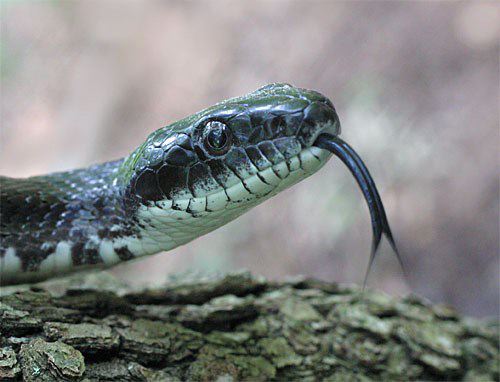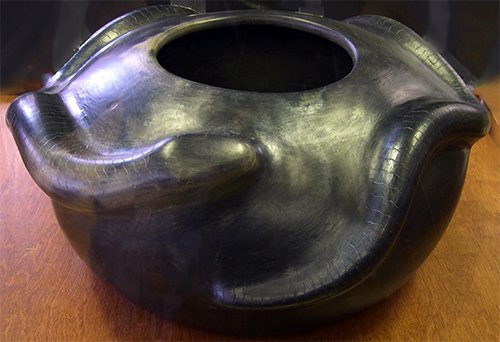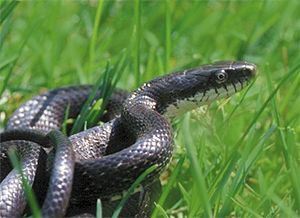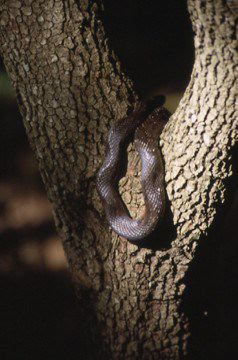 HOME: www.hiltonpond.org |
|||
|
THE BLACKSNAKE IN CATAWBA INDIAN ART |
|
The following copyrighted article was written exclusively for the Web site of Hilton Pond Center for Piedmont Natural History by Thomas J. Blumer, Ph.D. Dr. Blumer was a noted authority on the Catawba Indians and their history. He had more than 1,000 pieces of Catawba pottery in his personal collection--many of which he donated for exhibit at the University of South Carolina-Lancaster. 
All text & photos © Hilton Pond Center One of the most sought-after Catawba Indian clay vessels is the venerable snake pot. Of the 100 or more traditional Catawba shapes it most often approaches the masterpiece level. Nearly all potters make them, and snake pots sell quickly. They range from thimble-size miniatures fondly called "worm pots" to large sculpted works of great art. The largest snake pots are often several gallons in size. The making of this vessel is not just a whim on the part of the potters. It represents an ancient symbol tied to a very interesting part of Catawba Indian folklore and history.
All text & photos © Hilton Pond Center The serpent portrayed on the snake pot is most often the blacksnake. No one knows the origin of the blacksnake in Catawba culture and art. At the least it is hundreds of years old--perhaps even thousands of years. It may have entered the Catawba imagination with the invention of body painting and tattoo art in the pre-historic period. It also may be linked to the origin of pottery-making art in the Carolinas, circa 4,200 B.C. By the time of European contact, Catawba Indians had long tattooed the backs of their respected war captains with two blacksnakes, one on each shoulder blade. The cult of the serpent and the practice of decorating the back of the war captain was practiced from the Carolinas to Texas; across this entire region Indians interpreted the blacksnake insignia as that of a respected war captain. Male warriors of renown most often held this rank but respected women were also honored with this coveted title. Objects held special by war captains were decorated with the blacksnake or other serpents, including shell gorgets and perhaps even items of ritual use such as clothing. Gorgets depicting snakes are found in archaeological digs, but perishable items such as cloth or leather garments embellished with serpents soon decayed after being discarded or buried with a deceased war captain.
The Catawba abandoned the art of tattooing in the 18th century. The last war captain--probably Pine Tree George of Revolutionary War fame--died during this period. Toward the end of his military career, Pine Tree George was presented with a silver gorget by American authorities. The front contains his name in bold letters. Not happy with only his name, which he probably could not read, George engraved the reverse of his prized tribute with two blacksnakes. Today this treasured piece of royal regalia is preserved in the Catawba Nation Archives in Rock Hill, South Carolina. Although the 19th century Catawba no longer had war captains, love and respect for the blacksnake symbol continued. Instead of tattooing twin serpents on the back of a respected tribal member the Indians began to grace simple cooking pots with the blacksnake insignia. In 1913 when a group of Catawba attended the Corn Exposition in Columbia SC, two of the female dancers--Rosie Wheelock and Rachel Brown--wore regalia with appliquéd blacksnakes on the bosom. Nearly a century later, love and respect for the blacksnake continues to dominate Catawba culture and art. One of the Catawbas most celebrated in modern folklore is Dovie Harris. Many of today's elders recall Dovie standing at the edge of the forest with her hands held high above her head chanting, "All ye snakes and lizards come unto me." Dovie always claimed she could summon the blacksnake to do her bidding. She reportedly did not use the traditional cane switch to discipline her children when they misbehaved but switched them with a blacksnake called up for that purpose.
Today nearly all adult Catawba potters build and sell snake pots. Those made by master potters are indeed masterpieces destined to find a home in museum display cases. Snake pots by Earl Robbins, by his daughter Margaret Tucker, and by Cheryl Sanders, Monty Branham, Caroleen Sanders, and Marcus Sanders are in particular demand, while Edwin Campbell is known for his miniature "worm pots." All text & photos © Hilton Pond Center |

 In 1769, Benjamin West painted his famous oil "The Death of General Wolfe." In it, West pictured an Indian war captain crouched at the feet of the dying general. The war captain's back is appropriately decorated with two tattooed serpents. The Indian in the painting remains unidentified but there is a good possibility he is a Catawba that West saw during his early years in Pennsylvania. If the Indian is not a Catawba, he is certainly from one of the southern tribes that universally used the blacksnake symbol.
In 1769, Benjamin West painted his famous oil "The Death of General Wolfe." In it, West pictured an Indian war captain crouched at the feet of the dying general. The war captain's back is appropriately decorated with two tattooed serpents. The Indian in the painting remains unidentified but there is a good possibility he is a Catawba that West saw during his early years in Pennsylvania. If the Indian is not a Catawba, he is certainly from one of the southern tribes that universally used the blacksnake symbol. As the story goes, on one bright and cloudless day Dovie moved her rocking chair from the shaded porch to the unshaded yard. She sat down to appreciate the warmth of the sun's rays and closed her eyes to nap a bit before taking up her pottery-making chores. Soon she felt her favorite cat jump up onto her lap. Dovie never opened her eyes but stroked the cat until they both fell asleep. Upon waking, Dovie discovered she had a big blacksnake coiled up on her lap. It was so large its tail stretched out into the yard. Dovie's cat was nowhere to be seen.
As the story goes, on one bright and cloudless day Dovie moved her rocking chair from the shaded porch to the unshaded yard. She sat down to appreciate the warmth of the sun's rays and closed her eyes to nap a bit before taking up her pottery-making chores. Soon she felt her favorite cat jump up onto her lap. Dovie never opened her eyes but stroked the cat until they both fell asleep. Upon waking, Dovie discovered she had a big blacksnake coiled up on her lap. It was so large its tail stretched out into the yard. Dovie's cat was nowhere to be seen.


